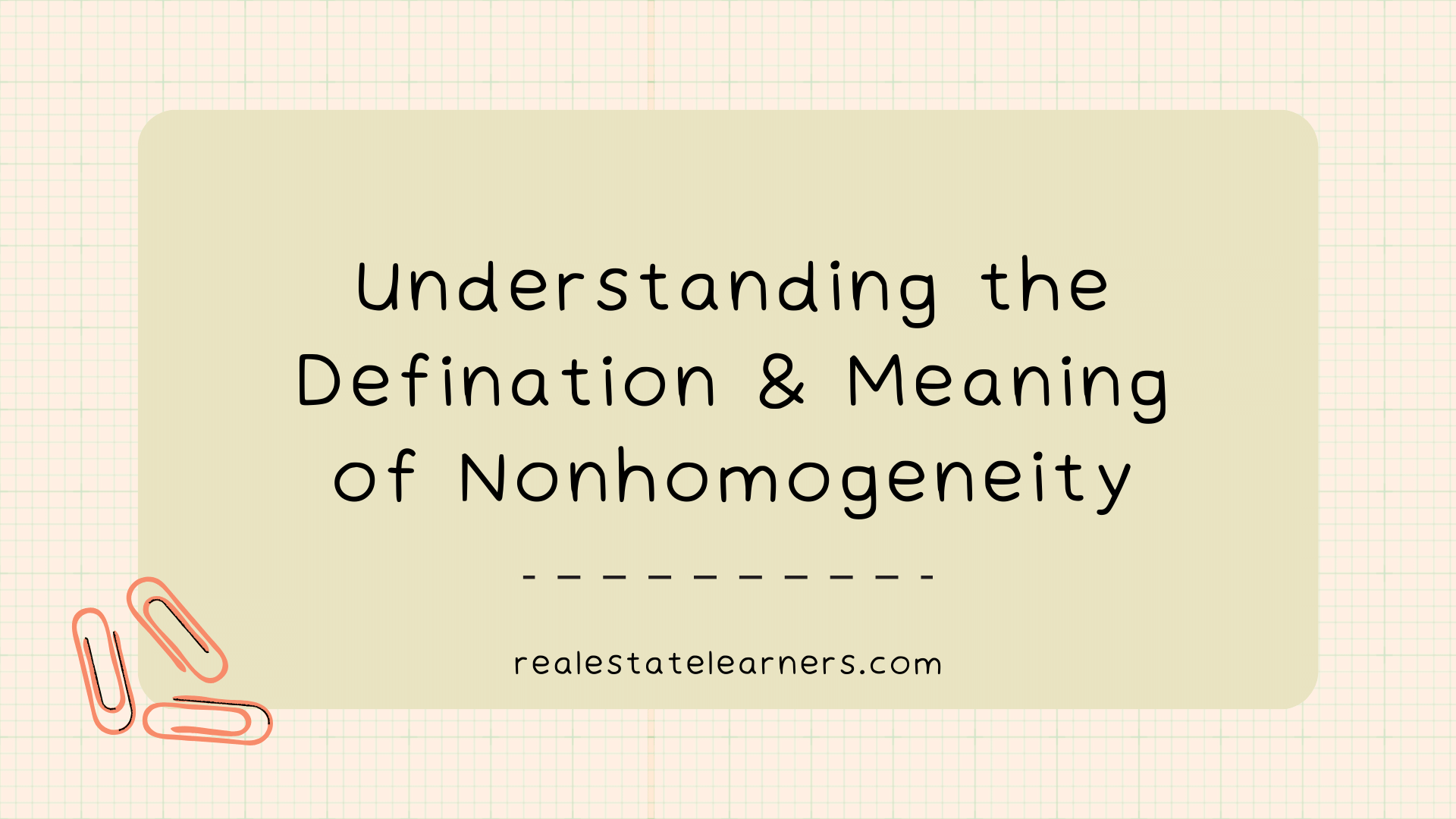Nonhomogeneous real estate is a term that refers to properties or buildings that are unique and cannot be easily compared to others in the same market. These types of properties have distinct features, making them difficult to evaluate based on traditional methods used for homogeneous real estate. We will discuss all the essential factors that contribute to nonhomogeneous real estate and how they affect the buying and selling process.
What is the Definition of Nonhomogeneity Real Estate ?
Nonhomogeneity in real estate refers to a property or neighborhood that lacks uniformity, either in terms of physical characteristics or socio-economic status. This means that the properties in the area may vary widely in size, style, condition, age, and price range. Nonhomogeneous neighborhoods can also have a mix of residential and commercial properties, making it more challenging to assess property values.
Also, non homogeneity real estate can also refer to a specific property that stands out from others in the same market due to unique features or characteristics. These could include historical significance, architectural style, or special amenities that are not found in other properties.
What is non homogeneity in real estate?
Non homogeneity in real estate means that no two properties are exactly alike. Each property has its unique features, characteristics, and value. This is due to various factors such as location, size, age, condition, amenities and layout. Even properties that appear similar on the surface may have subtle differences that can impact their market value. This makes it difficult to compare properties and accurately price them.
Non homogeneity also means that buyers must consider a wide range of factors when purchasing, as each property may offer different benefits and drawbacks. Ultimately, nonhomogeneity highlights the complexity and subjectivity of real estate valuation. Additionally, it emphasizes the importance of conducting thorough research and due diligence before buying or selling a property.
Examples-
- A spacious, newly built apartment in a prime location may have a higher market value than a similar-sized unit in a less desirable area due to its proximity to amenities and transportation options.
- An older house with outdated fixtures and appliances may have a lower market value than a newer home with modern upgrades, even if they are both the same size and located in the same neighborhood.
- A piece of land with a scenic view and natural features may have a higher market value than a neighboring plot that lacks these attributes, even if they are both zoned for residential use. These examples demonstrate how nonhomogeneity plays a significant role in real estate valuation and highlight the importance of considering multiple factors when determining the worth of a property.
- A commercial building with ample parking and easy access to major highways may have a higher market value than a similar-sized building in the same area that lacks these conveniences, as it may attract more tenants and generate higher profits.
- An older home with historic architectural features and charm may have a higher market value than a newer home with a modern design, as it may appeal to buyers looking for a unique and character-filled property.
This showcases how nonhomogeneity can also be subjective, as different buyers may place value on various features of a property. Ultimately, understanding the concept of non homogeneity is crucial for anyone involved in the real estate market to assess and understand properties’ value accurately.
What is the difference between nonhomogeneity and homogeneity?
Homogeneity, however, refers to properties that share similar characteristics and are relatively uniform in size, style, age, and price range. This is often found in planned communities or developments where properties are built with a similar design and target a specific demographic.
Unlike non-homogenous areas, homogenous neighborhoods typically have more consistent property values as there is less property variation.
What is the Importance of Non-Homogeneity in Real Estate?
The concept of non homogeneity is essential in real estate for several reasons:
Accurate Valuation: Nonhomogeneity highlights the need to consider multiple factors when determining the value of a property, as no two properties are exactly alike. This can help prevent over or underpricing and ensure fair transactions.
Understanding Market Trends: Real estate professionals can better understand market trends and make informed decisions by recognizing the unique features that impact property values in a specific area.
Diverse Investment Opportunities: Nonhomogeneity allows for a diverse range of investment opportunities in different types of properties, catering to the needs and preferences of various buyers.
Flexibility in Decision Making: The variations within nonhomogeneous areas provide more options for buyers, allowing them to choose a property that best suits their needs and budget.
Leveraging Features: Nonhomogeneity allows for leveraging unique features of a property in marketing tactics, making it more attractive and potentially increasing its value.
Conclusion
After discussing the concept of nonhomogeneous real estate, it is clear that this type of property plays a significant role in the real estate industry. Nonhomogeneous properties are characterized by their unique characteristics and lack of uniformity, making them highly sought after by investors.
One key advantage of nonhomogeneous real estate is its potential for higher returns on investment. Due to its unique characteristics, nonhomogeneous properties often have a higher value than homogeneous properties with similar features. This makes them attractive to investors looking for higher returns.

Corey has over 15 years of experience as a real estate broker and educator. He is dedicated to providing valuable insights and guidance for those looking to enter the real estate industry.

